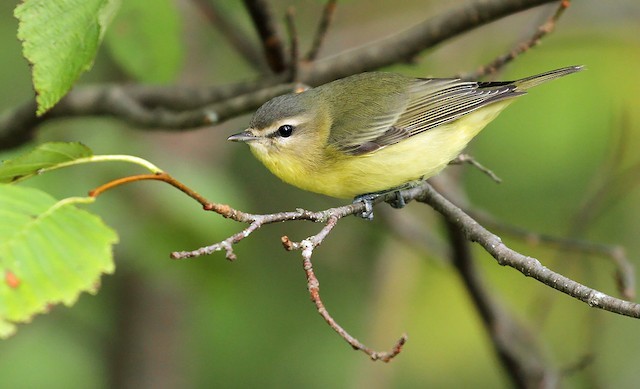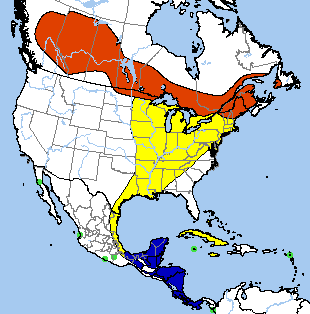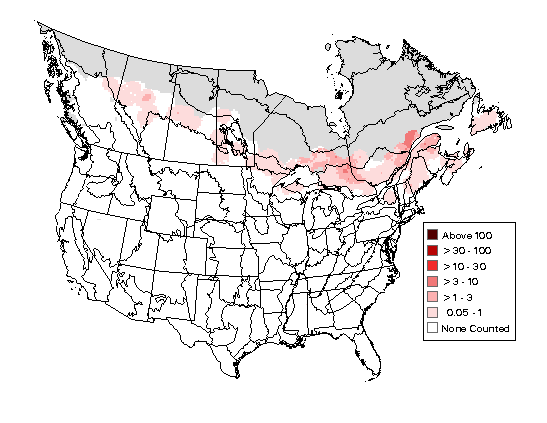Birdfinding.info ⇒ Fairly easy to find in some of its breeding areas, but otherwise uncommon and usually chanced upon unexpectedly. On spring migration, briefly becomes fairly common along the Texas coast and at certain sites in the Great Lakes, such as Magee Marsh (Ohio) and Point Pelee National Park (Ontario).
Philadelphia Vireo
Vireo philadelphicus
Breeds in the boreal forest zone of North America. Winters from eastern Mexico to Colombia. Uncommon but likely overlooked because its song is so similar to Red-eyed Vireo’s.
Breeding. Mainly in aspen, poplar, and birch woodland across Canada from the southern Yukon and northern British Columbia to Newfoundland, south to northern Minnesota and Wisconsin, the Upper Peninsula of Michigan, the Adirondacks, and northern New England.
Nonbreeding. Winters from the Yucatán Peninsula and southern Veracruz south throughout Central America to northwestern Colombia. Most numerous from Honduras to western Panama.
Movements. Northbound migration is mostly between the Great Plains and the Appalachians. Southbound migration is more dispersed, with some following the Eastern Seaboard and strays appearing in small numbers west to California and east into the West Indies.
Identification
A soft pastel yellow-and-olive vireo with a dark eyeline bordered by a whitish eyebrow and whitish crescent below. Has a small, slightly upturned bill, which contributes to its gentle, dovish expression.
Upperparts are mostly olive, usually darker and grayer on the crown. Underparts vary from whitish to bright yellow.
In fresh spring plumage, usually has just a slight yellowish wash. During summer the underparts brighten, and by fall some individuals are vivid yellow, especially on the breast. However, some fall birds (maybe just immatures) are as drab as the spring plumage and readily confused with Warbling Vireo (see below).
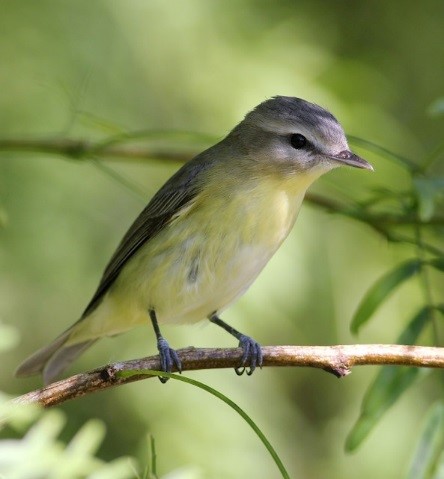
Philadelphia Vireo. (Leonabelle Turnbull Birding Center, Port Aransas, Texas; May 6, 2017.) © Jason Leifester
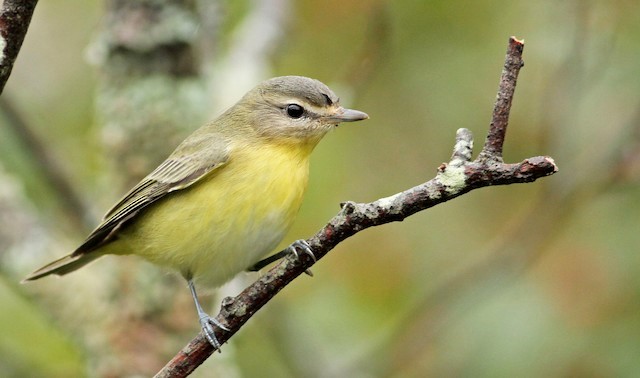
Philadelphia Vireo. (Monhegan Island, Maine; September 22, 2011.) © Luke Seitz

Philadelphia Vireo. (Magee Marsh, Ohio; May 12, 2018.) © Zachary DeBruine
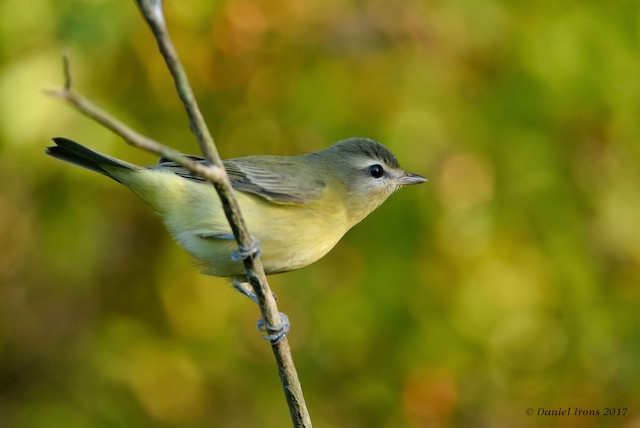
Philadelphia Vireo. (Queen Anne’s County, Maryland; September 10, 2017.) © Daniel Irons
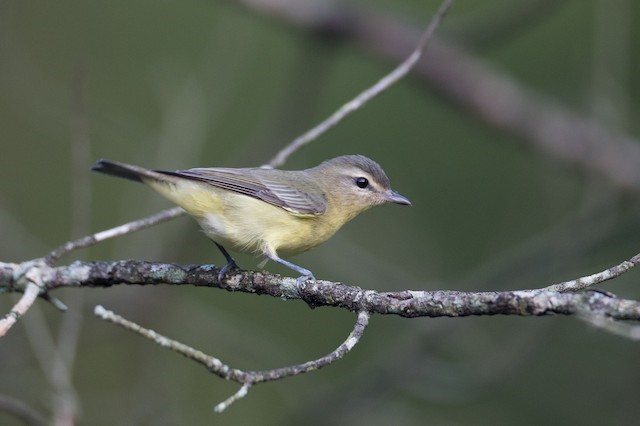
Philadelphia Vireo. (Lime Hollow, Cortland, New York; September 7, 2015.) © Chris Wood
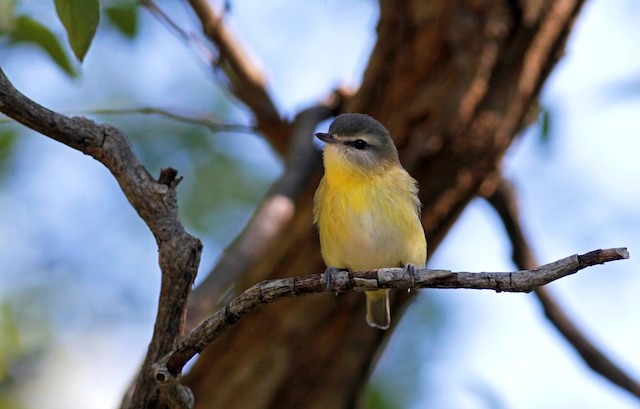
Philadelphia Vireo. (Plum Island, Massachusetts; September 25, 2016.) © Miles Brengle
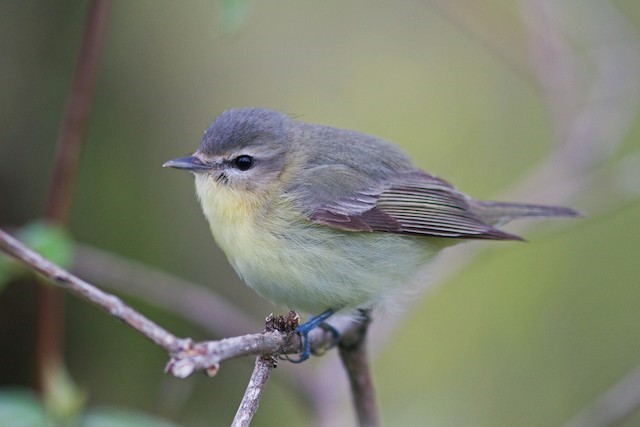
Philadelphia Vireo. (Magee Marsh, Ohio; May 16, 2011.) © David Disher
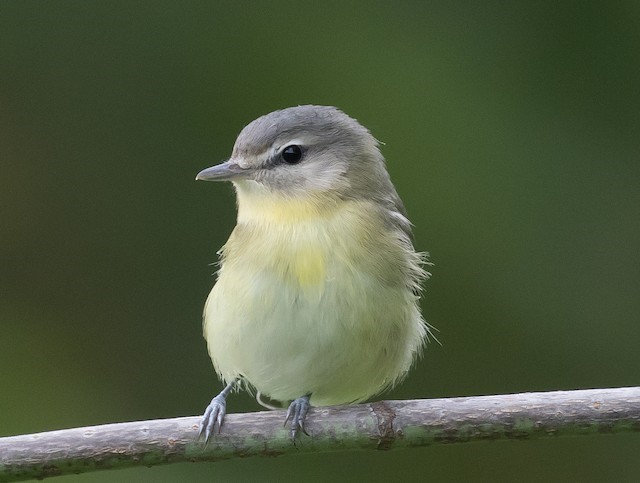
Philadelphia Vireo. (The Riverwood Conservancy, Mississauga, Ontario; September 20, 2018.) © Ian Burgess

Philadelphia Vireo. (Cherry Hill Nature Preserve, Superior Charter Township, Michigan; September 18, 2017.) © Brendan Klick
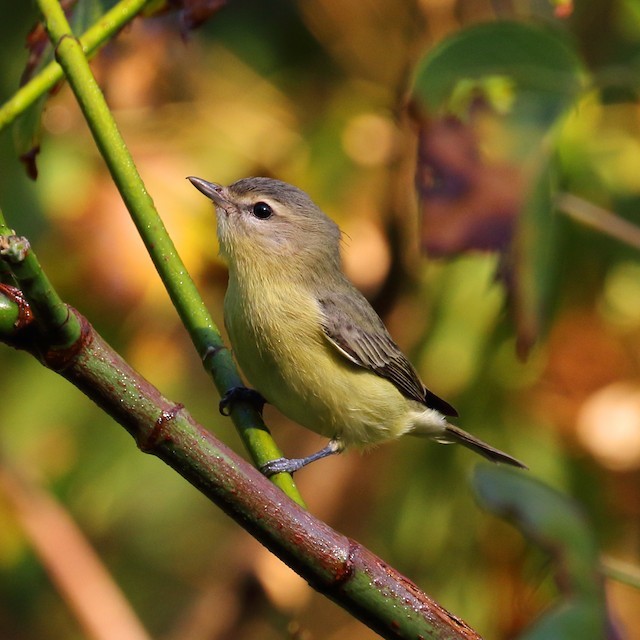
Philadelphia Vireo. (Sandy Springs, Georgia; May 12, 2018.) © Dan Vickers

Philadelphia Vireo. (Caroline, New York; September 16, 2017.) © Steve Kelling

Philadelphia Vireo. (Queen Anne’s County, Maryland; September 10, 2017.) © Daniel Irons

Philadelphia Vireo. (Tifft Nature Preserve, Buffalo, New York; May 18, 2015.) © Sue Barth
Voice. Song is very similar to that of Red-eyed Vireo: mostly 3- and 4-note phrases at fairly regular intervals, usually in a call-and-response pattern, alternating between phrases that end with an upward inflection and phrases that end downward: Philadelphia’s song is typically higher-pitched than Red-eyed’s, with longer pauses and briefer phrases.
Cf. Warbling Vireo. Philadelphia and Warbling Vireos can be very difficult to distinguish visually. Warbling is a drabber, washed-out version of Philadelphia, so the plainest Philadelphias are extremely similar to the brightest Warblings—especially the western subspecies, which tend to have more contrasty features than the eastern subspecies. The most consistent difference is in the pattern of yellow on the underparts. Philadelphia is brightest on the middle of the chest, whereas Warbling is usually brightest on the flanks.
Cf. Red-eyed Vireo. Philadelphia and Red-eyed Vireos differ in apparent size and facial pattern. Red-eyed is somewhat larger, with a proportionately larger bill than Philadelphia’s. Red-eyed has a longer, more pronounced white eyebrow that is framed by crisp blackish lines above and below. In overall coloration, Red-eyed typically has a greener back and bluer crown, with contrastingly white or grayish-white underparts, whereas Philadelphia’s upperparts are more muted and its underparts are flushed with yellow.
Notes
Monotypic species.
References
Alderfer, J., and J.L. Dunn. 2014. National Geographic Complete Birds of North America (Second Edition). National Geographic Society, Washington, D.C.
eBird. 2018. eBird: An online database of bird distribution and abundance. Cornell Lab of Ornithology, Ithaca, N.Y. http://www.ebird.org. (Accessed November 20, 2018.)
Garrido, O.H, and A. Kirkconnell. 2000. Field Guide to the Birds of Cuba. Cornell University Press, Ithaca, N.Y.
McMullan, M., and T. Donegan. 2014, Field Guide to the Birds of Colombia (Second Edition). Fundación Proaves de Colombia, Bogotá.
Raffaele, H., J. Wiley, O. Garrido, A. Keith, and J. Raffaele. 1998. A Guide to the Birds of the West Indies. Princeton University Press, Princeton, N.J.
Salt, W.R., and J.R. Salt. 1976. The Birds of Alberta. Hurtig Publishers, Edmonton, Alberta.
